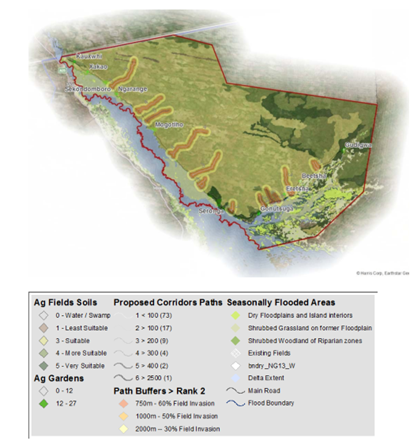Conserving transboundary landscapes – why prioritising local community needs is key
Our nature expert, Chris Brooks, looks at how, through an iterative and participatory process, an innovative land use planning tool is helping both wildlife and local communities.
-
Date
December 2022
-
Area of expertiseClimate, Energy, and Nature
-
KeywordsNature and environment , Biodiversity , Circular economy , Climate change adaptation , Climate governance , Forestry and land use , Adaptive management , Policy implementation , Policy options , Technical assistance
The first of the four goals for the post 2020 Global Biodiversity Framework is to enhance the integrity of all ecosystems. The goal aims to increase the area, connectivity and integrity of natural systems, so that they are better able to support healthy wildlife populations by giving them the space to move, find food and water, as well as to find mates and maintain their genetic diversity.
Much of the higher profile work that is currently underway that will help countries to achieve this goal is being done on large, often international scales where the focus is to conserve landscapes as holistic ecosystems. This approach ensures that the full range of ecological and habitat diversity within any ecosystem is conserved, and allows wildlife and birdlife to move between habitats at different times of the year when food is most plentiful, or where the rains are falling. The approach is critical as it addresses many of the failings of initial conservation efforts of the late 19th Century and early 20th Century where Protected Areas were often demarcated based upon their aesthetic quality, or the mass concentration of animals they supported at any one point in time.
The result, when seen across much of the African continent, is a series of isolated protected areas with wildlife populations contained by a landscape that has changed through more recent human habitation and agricultural land reform. On the surface, the wildlife populations within these protected areas seem ‘content’ and well conserved, but with the impacts of climate change driving dramatic shifts in rainfall and habitat quality, and the land use around protected areas changing at ever faster rates driven by a growing global human population, the resilience of these wildlife populations is significantly reduced.
International and national support
Organisations such as the Peace Parks Foundation in southern Africa, facilitate international cooperation to develop wildlife conservation areas that span country borders. Linking protected areas across multiple countries, these Transfrontier Conservation Areas (TFCAs) have had success in galvanising regional and international support for the improved management of both the protected areas and ‘buffer’ zones around these parks. These International efforts and those of national authorities within each country have helped to secure wildlife corridors linking protected areas across these vast landscapes and allowing wildlife to maintain ancient migration routes and follow rainfall patterns or adapt to current climatic conditions and disperse to areas with better food or more mating opportunities. When mapped out these TFCAs are truly vast, the Kavango Zambezi (KAZA) TFCA that covers parts of Angola, Botswana, Namibia, Zambia and Zimbabwe is 520,000km2 - larger than Spain or Thailand. But the success of these efforts is not just about their scale, which is important, but what happens at the micro-scale within these landscapes.
Localised initiatives can often be more dynamic, allowing area-specific solutions to be implemented that directly respond to local needs. The smaller, more localised the scale of these initiatives the better they can address the challenges of people neighbouring the protected areas, helping to mitigate the impact of conflicts with wildlife moving out of the parks and identifying opportunities for these communities to benefit economically from these parks.
A win-win for wildlife and local communities
USAID has been funding one such project in northern Botswana, Resilient Waters, which seeks to roll out a participatory land use planning tool to assist in land allocation that is beneficial to both rural communities and the wildlife that surrounds them. Called LUCIS, the GIS program integrates data on an area’s physical geography (soil, topography, water availability) with information provided by community members on what the optimal uses of land for them would be in each parcel of land within the buffer zones around and between these protected areas. The iterative and participatory process ranks requirements by each group of stakeholders within each community to support the allocation of land optimally for different land uses and users, i.e., for urban development or for pastoral farmers and arable farmers.
The process helps national and provincial land authorities to identify arable fields in areas with fertile soils and accessible water, but outside of critical wildlife corridors where the risk of conflict through crop-raiding by elephants and direct human-animal interactions is high. Village development zones are sited in areas where development already exists but also outside of areas with high-flood risk and not in prime arable farming areas. The approach provides space for both human and wildlife users of the landscape, reducing human-wildlife conflict and protecting connectivity between protected areas without negatively impacting human livelihoods. Where LUCIS has been applied, the emphasis has been to ensure land allocation enhances existing livelihoods, and facilitates opportunities for new and divergent livelihoods that help communities to tap into and maximise benefits from economic opportunities such as ecotourism, or sustainable fisheries.
In the trial region of northern Botswana the majority of human-wildlife conflict is between people and the area’s large elephant population, with much of this conflict occurring as elephants come into close contact with both people and their crops as they move to and from water on the edge of the Okavango Delta.

A map identifying soil suitability for arable farming alongside identified elephant corridors to the northeast of the Okavango Delta through the LUCIS tool used by USAID and the NGO Ecoexist
Recognition of results
Most importantly, the role played by communities during the participatory LUCIS process in defining what they need and prioritise for allocation by national and provincial authorities has created significant buy-in to the process, formally recognising their needs from a bottom-up perspective. The efficiency and effectiveness of the process has also been appreciated by local government employees who are responsible for land allocation at the community level, as highlighted by one sub-land Board Secretary: “We welcome LUCIS as a tool that will really help us with land allocation and avoid land use conflicts in the Okavango District. We have already seen that it is working and I’m sure it will help us, through digital transformation, to address sustainable development and ensure that critical movement corridors are maintained for the wildlife of the Okavango.”
Considering the needs of the communities that live with wildlife is key to ensuring the long-term success of goals such as the Post 2020 Biodiversity Framework that aim to improve the conservation of all ecosystems at scale. Initiatives such as LUCIS, that consider community needs along with the needs of wildlife must be a key part of the ongoing efforts to protect connectivity. As human populations across Africa and other parts of the world increase, the resulting need for more land to support these populations will, along with climate change, be one of the biggest threats to biodiversity. Developing tools that allow both human and wildlife needs to be considered together as part of participatory and integrated land use planning processes is imperative if the long-term goals of COP15 are to be achieved.
About the authors:
Chris Brooks is OPM's Lead for Nature and Environment and has supported transboundary conservation initiatives in southern Africa for the past two decades. His interests and areas of expertise cover catchment management, water security, biodiversity conservation, wildlife management, climate smart agriculture and urban resilience.
Hattie Bartlam-Brooks spent more than 15 years as a wildlife researcher in Botswana, following and observing the migration routes of zebra out of the Okavango Delta and helping to contribute to the conservation goals of the country's Wildlife Department. She is currently completing her Masters in Science Communications at Imperial College, London.

